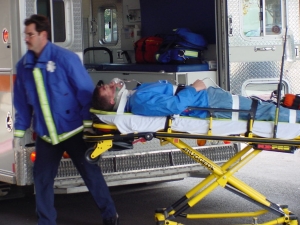
Ambulance responses in our region raise alarms: Part IV in a series
By Miriam Raftery
April 6, 2015 (San Diego’s East County)—San Diego County’s contract with its new ambulance provider for East County, Mercy, requires that response times be less than 30 minutes 90% of the time in rural areas and 10 minutes in urban areas. That’s too long if you’ve had a heart attack or other major trauma.
When we inquired about response times, County staff advised us that in 2014, the County Fire Authority (ie Cal Fire) had a better response time than the requirement, averaging just over 10 minutes, while the former ambulance provider, AMR, average about 14 minutes. (Read more)
But why does the County’s contract list 30 minutes as an acceptable standard for most emergency calls in rural areas? A special investigation by East County Magazine could find no other jurisdiction with such a long allowable response time. We checked through online searches of other agencies in California, the U.S. and foreign countries, to the degree that such data was available (and many agencies don’t disclose response times).
There is no official federal standard for response times according to the emergency medical services trade publication EMS World in 2004, though some states, counties, cities, and foreign nations do set their own standards—and many have far better records than San Diego County. Calfiornia's Emergency Medical Services Authority does have a standard for response times in rural and suburban areas of 15 minutes or less for basic life support services and 20 minutes or less for advanced life support services, with defribrillation "as quickly as possible. (See p. 26 here) So it's unclear why San Diego has a worse standard than the state's, mandating only 30 minutes.
Data is spotty, and not always up to date. None-the-less, the findings shine light on the potential to do far better.
The entire state of Mississippi achieved an average ambulance response time of just six minutes from dispatch to location in 1977, the state’s department of health reported (See p. 13). If a poor Southern state with many rural areas could manage this, why can’t San Diego County?
Wales, a predominantly rural country belonging to Great Britain, is over 8,000 square miles (bigger than San Diego County) and has a population of over 3 million. Over half of emergency ambulance responses to immediately life threatening situations arrived within 8 minutes in February 2015, with a median response time of 7 minutes and 49 seconds, though less serious calls took longer, according to Welsh government statistics.
In Australia’s New South Wales region, in 2013-14, the government reported that the highest priority calls for life-threatening cases were responded to in less than 8 minutes over half the time.
Israel, interestingly, uses “ambucycles” to swiftly reach those in medical need as a supplement to conventional ambulance services. The average response time nationally is just three minutes, San Diego Jewish World has reported.
Riverside County, just northeast of San Diego, manages average response times ranging from 3.29 minutes to 9.59 minutes, depending on the fire department involved. The highest was for Idyllwild, a mountain community, and the lowest was Pechanga, an Indian reservation. Riverside County’s Fire Department has an 8.3 minute response time on average, while the city of Riverside averages just over 5 minutes, according to a February 2014 report prepared by Riverside County on emergency medical services.
The City of San Diego was recently taken to task by the County Grand Jury for slow response times during 2013-14 in six areas: Home Avenue, Paradise Hills, the College area, Skyline, Encanto, and Stresemann/Governor. “It is a known that there is a need for major rebuilding and building of new fire houses,” the Grand Jury report stated.
The City was striving for a 12-minute response time or less – far better than the 30-minute response time that the County contract deems acceptable in rural areas.
Admittedly some rural residents are in locations so remote that very short response times would be unattainable. But for those living in or near towns or highways, shouldn’t the county expect better? Areas like Potrero or Deerhorn Valley too often have to wait long periods for medical aid to arrive because there are no paramedic units stationed in their towns.
The anguish felt by residents is exemplified by Hilary Dixon. In a letter to Supervisor Dianne Jacob, Dixon recalled that back in 2010, “Where was the County…when I placed a 911 call for my 13-year-old son in a diabetic coma?” Dixon says the first units to respond had no paramedics. She recalls that it was “terrifying to watch your son with blue lips shaking, unresponsive in a diabetic coma with the fire department unable to assist since not all the stations in Jamul and elsewhere have paramedics, for two hours!”
Jamul’s Fire Department now has its own 24/7 paramedic unit, so the situation has improved in that regard. The county says that counting multiple agencies there will soon be 13 ambulances to serve East County’s unincorporated areas along the I-8 and highway 94 corridors.
But the question remains: why does our county’s contract with its ambulance providers – new and old—require only a 30 minute response time, 90% of the time?
Brain death occurs within minutes after a heart attack, without emergency medical intervention. In a highway collision where victims are bleeding severely or have other major injuries, every minute counts.
Perhaps instead, the county should set standards that assure all taxpayers in the county could have a reasonable expectation of receiving ambulance service within a short time frame when their life depends upon it.
Or, perhaps, the County Grand Jury should take a look at the County’s ambulance response times, and make recommendations to further improve emergency medical services in rural areas.







Comments
What is the average ambulance
The "San Diego Discount"
There are 4 ALS County
Which jurisdictions?
Paramedic engine locations